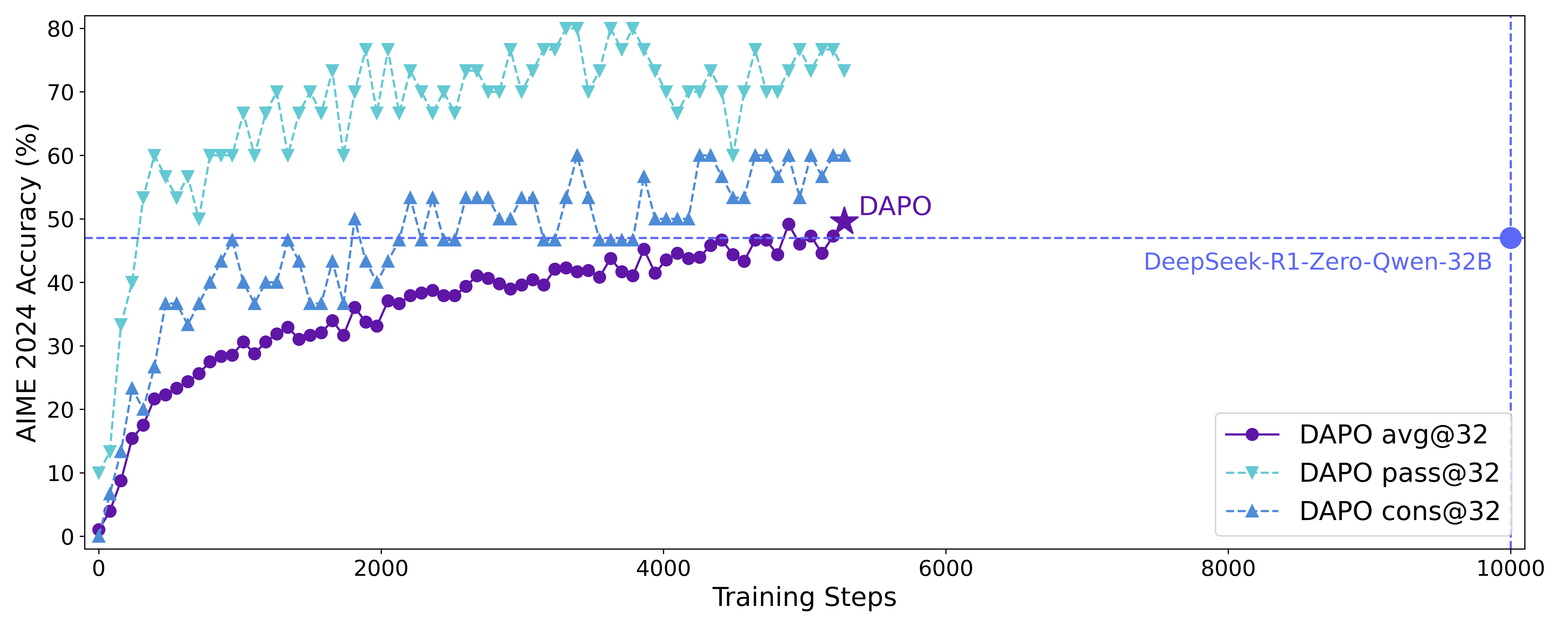Recipe: Decoupled Clip and Dynamic Sampling Policy Optimization (DAPO)
Last updated: 06/19/2025.
Open-Source Algorithm Implementation & Expriement Running: Yuxuan Tong, Guangming Sheng
🏠 Homepage | 📝 Paper@arXiv | 🤗 Datasets&Models@HF | 🐱 Code@GitHub | 🐱 Repo@GitHub
We propose the Decoupled Clip and Dynamic sAmpling Policy Optimization (DAPO) algorithm. By making our work publicly available, we provide the broader research community and society with practical access to scalable reinforcement learning, enabling all to benefit from these advancements. Our system is based on the awesome verl framework. Thanks for their great work! Applying DAPO training to Qwen2.5-32B base model proves to outperform the previous state-of-the-art DeepSeek-R1-Zero-Qwen-32B on AIME 2024, achieving 50% accuracy with 50% less training steps.
Quickstart
Prepare the datasets on the Ray cluster:
bash prepare_dapo_data.sh # This downloads the datasets to ${HOME}/verl/data by default
Submit the job to the Ray cluster from any machine:
cd verl # Repo root
export RAY_ADDRESS="http://${RAY_IP:-localhost}:8265" # The Ray cluster address to connect to
export WORKING_DIR="${PWD}" # The local directory to package to the Ray cluster
# Set the runtime environment like env vars and pip packages for the Ray cluster in yaml
export RUNTIME_ENV="./recipe/dapo/runtime_env.yaml" # This sets environment variables for the Ray cluster
bash recipe/dapo/run_dapo_qwen2.5_32b.sh # or other scripts
Reproduction Runs
Setup |
AIME 2024 Acc. |
Hardware |
Image |
Commit |
Environment Variables |
Training Script |
Training Record |
|---|---|---|---|---|---|---|---|
DAPO |
52% |
16x8xH800 |
|
||||
DAPO w/o Dynamic Sampling |
50% |
16x8xH800 |
|
||||
DAPO w/o Token-level Loss & Dynamic Sampling |
44% |
16x8xH20 |
|
[!IMPORTANT]
📢 Call for Contribution!
Welcome to submit your reproduction runs and setups!
Configuration
Separated Clip Epsilons (-> Clip-Higher)
An example configuration:
actor_rollout_ref:
actor:
clip_ratio_low: 0.2
clip_ratio_high: 0.28
clip_ratio_low and clip_ratio_high specify the $\varepsilon_{\text {low }}$ and $\varepsilon_{\text {high }}$ in the DAPO objective.
Core relevant code:
pg_losses1 = -advantages * ratio
pg_losses2 = -advantages * torch.clamp(ratio, 1 - cliprange_low, 1 + cliprange_high)
pg_losses = torch.maximum(pg_losses1, pg_losses2)
Dynamic Sampling (with Group Filtering)
An example configuration:
data:
gen_batch_size: 1536
train_batch_size: 512
algorithm:
filter_groups:
enable: True
metric: acc # score / seq_reward / seq_final_reward / ...
max_num_gen_batches: 10 # Non-positive values mean no upper limit
Setting filter_groups.enable to True will filter out groups whose outputs’ metric are all the same, e.g., for acc, groups whose outputs’ accuracies are all 1 or 0.
The trainer will repeat sampling with gen_batch_size until there are enough qualified groups for train_batch_size or reaching the upper limit specified by max_num_gen_batches.
Core relevant code:
prompt_bsz = self.config.data.train_batch_size
if num_prompt_in_batch < prompt_bsz:
print(f'{num_prompt_in_batch=} < {prompt_bsz=}')
num_gen_batches += 1
max_num_gen_batches = self.config.algorithm.filter_groups.max_num_gen_batches
if max_num_gen_batches <= 0 or num_gen_batches < max_num_gen_batches:
print(f'{num_gen_batches=} < {max_num_gen_batches=}. Keep generating...')
continue
else:
raise ValueError(
f'{num_gen_batches=} >= {max_num_gen_batches=}. Generated too many. Please check your data.'
)
else:
# Align the batch
traj_bsz = self.config.data.train_batch_size * self.config.actor_rollout_ref.rollout.n
batch = batch[:traj_bsz]
Flexible Loss Aggregation Mode (-> Token-level Loss)
An example configuration:
actor_rollout_ref:
actor:
loss_agg_mode: "token-mean" # / "seq-mean-token-sum" / "seq-mean-token-mean"
# NOTE: "token-mean" is the default behavior
Setting loss_agg_mode to token-mean will mean the (policy gradient) loss across all the tokens in all the sequences in a mini-batch.
Core relevant code:
if loss_agg_mode == "token-mean":
loss = verl_F.masked_mean(loss_mat, loss_mask)
elif loss_agg_mode == "seq-mean-token-sum":
seq_losses = torch.sum(loss_mat * loss_mask, dim=-1) # token-sum
loss = torch.mean(seq_losses) # seq-mean
elif loss_agg_mode == "seq-mean-token-mean":
seq_losses = torch.sum(loss_mat * loss_mask, dim=-1) / torch.sum(loss_mask, dim=-1) # token-mean
loss = torch.mean(seq_losses) # seq-mean
else:
raise ValueError(f"Invalid loss_agg_mode: {loss_agg_mode}")
Overlong Reward Shaping
An example configuration:
data:
max_response_length: 20480 # 16384 + 4096
reward_model:
overlong_buffer:
enable: True
len: 4096
penalty_factor: 1.0
Setting overlong_buffer.enable to True will penalize the outputs whose lengths are overlong but still within the hard context limit.
Specifically, the penalty increases linearly from 0 to overlong_buffer.penalty_factor when the length of the output exceeds the max_response_length by 0 to overlong_buffer.len tokens.
Core relevant code:
if self.overlong_buffer_cfg.enable:
overlong_buffer_len = self.overlong_buffer_cfg.len
expected_len = self.max_resp_len - overlong_buffer_len
exceed_len = valid_response_length - expected_len
overlong_penalty_factor = self.overlong_buffer_cfg.penalty_factor
overlong_reward = min(-exceed_len / overlong_buffer_len * overlong_penalty_factor, 0)
reward += overlong_reward
FAQ
Where is the “Overlong Filtering” in the paper?
Most experiments in the paper, including the best-performant one, are run without Overlong Filtering because it’s somehow overlapping with Overlong Reward Shaping in terms of properly learning from the longest outputs. So we don’t implement it here.
What’s the difference between the recipe/dapo directory in the main branch and the recipe/dapo branch?
The recipe/dapo branch is for as-is reproduction and thus won’t be updated with new features.
The recipe/dapo directory in the main branch works as an example of how to extend the latest verl to implement an algorithm recipe, which will be maintained with new features.
Why can’t I produce similar results after modifications?
RL infrastructures nowadays still have inherent unrobustness, on which we are still working hard to improve.
We strongly recommend to only modify one thing at a time.
We also list some known problems here:
Enabling CUDA graph (
enforce_eager=False) might cause model performance degradation, whose cause is still under investigation.
